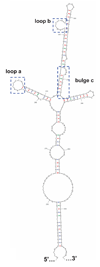The linker domain of poly(rC) binding protein 2 is a major determinant in poliovirus cap-independent translation
- PMID: 18656221
- PMCID: PMC2595138
- DOI: 10.1016/j.virol.2008.05.007
The linker domain of poly(rC) binding protein 2 is a major determinant in poliovirus cap-independent translation
Abstract
Poliovirus, a member of the enterovirus genus in the family Picornaviridae, is the causative agent of poliomyelitis. Translation of the viral genome is mediated through an internal ribosomal entry site (IRES) encoded within the 5' noncoding region (5' NCR). IRES elements are highly structured RNA sequences that facilitate the recruitment of ribosomes for translation. Previous studies have shown that binding of a cellular protein, poly(rC) binding protein 2 (PCBP2), to a major stem-loop structure in the genomic 5' NCR is necessary for the translation of picornaviruses containing type I IRES elements, including poliovirus, coxsackievirus, and human rhinovirus. PCBP1, an isoform that shares approximately 90% amino acid identity to PCBP2, cannot efficiently stimulate poliovirus IRES-mediated translation, most likely due to its reduced binding affinity to stem-loop IV within the poliovirus IRES. The primary differences between PCBP1 and PCBP2 are found in the so-called linker domain between the second and third K-homology (KH) domains of these proteins. We hypothesize that the linker region of PCBP2 augments binding to poliovirus stem-loop IV RNA. To test this hypothesis, we generated six PCBP1/PCBP2 chimeric proteins. The recombinant PCBP1/PCBP2 chimeric proteins were able to interact with poliovirus stem-loop I RNA and participate in protein-protein interactions. We demonstrated that the PCBP1/PCBP2 chimeric proteins with the PCBP2 linker, but not with the PCBP1 linker, were able to interact with poliovirus stem-loop IV RNA, and could subsequently stimulate poliovirus IRES-mediated translation. In addition, using a monoclonal anti-PCBP2 antibody (directed against the PCBP2 linker domain) in mobility shift assays, we showed that the PCBP2 linker domain modulates binding to poliovirus stem-loop IV RNA via a mechanism that is not inhibited by the antibody.
Figures











Similar articles
-
Distinct poly(rC) binding protein KH domain determinants for poliovirus translation initiation and viral RNA replication.J Virol. 2002 Dec;76(23):12008-22. doi: 10.1128/jvi.76.23.12008-12022.2002. J Virol. 2002. PMID: 12414943 Free PMC article.
-
Poly(rC) binding protein 2 binds to stem-loop IV of the poliovirus RNA 5' noncoding region: identification by automated liquid chromatography-tandem mass spectrometry.Proc Natl Acad Sci U S A. 1996 Oct 1;93(20):11115-20. doi: 10.1073/pnas.93.20.11115. Proc Natl Acad Sci U S A. 1996. PMID: 8855318 Free PMC article.
-
Altered interactions between stem-loop IV within the 5' noncoding region of coxsackievirus RNA and poly(rC) binding protein 2: effects on IRES-mediated translation and viral infectivity.Virology. 2009 Jun 20;389(1-2):45-58. doi: 10.1016/j.virol.2009.03.012. Epub 2009 May 14. Virology. 2009. PMID: 19446305 Free PMC article.
-
Elusive Trans-Acting Factors Which Operate with Type I (Poliovirus-like) IRES Elements.Int J Mol Sci. 2022 Dec 7;23(24):15497. doi: 10.3390/ijms232415497. Int J Mol Sci. 2022. PMID: 36555135 Free PMC article. Review.
-
Advances and Breakthroughs in IRES-Directed Translation and Replication of Picornaviruses.mBio. 2023 Apr 25;14(2):e0035823. doi: 10.1128/mbio.00358-23. Epub 2023 Mar 20. mBio. 2023. PMID: 36939331 Free PMC article. Review.
Cited by
-
Structures and Functions of Viral 5' Non-Coding Genomic RNA Domain-I in Group-B Enterovirus Infections.Viruses. 2020 Aug 21;12(9):919. doi: 10.3390/v12090919. Viruses. 2020. PMID: 32839386 Free PMC article. Review.
-
PCBP1 and PCBP2 both bind heavily oxidized RNA but cause opposing outcomes, suppressing or increasing apoptosis under oxidative conditions.J Biol Chem. 2020 Aug 21;295(34):12247-12261. doi: 10.1074/jbc.RA119.011870. Epub 2020 Jul 9. J Biol Chem. 2020. PMID: 32647012 Free PMC article.
-
Cellular mRNA decay protein AUF1 negatively regulates enterovirus and human rhinovirus infections.J Virol. 2013 Oct;87(19):10423-34. doi: 10.1128/JVI.01049-13. Epub 2013 Jul 31. J Virol. 2013. PMID: 23903828 Free PMC article.
-
Structure, function, and tethering of DNA-binding domains in σ⁵⁴ transcriptional activators.Biopolymers. 2013 Dec;99(12):1082-96. doi: 10.1002/bip.22333. Biopolymers. 2013. PMID: 23818155 Free PMC article.
-
PCBP2 enhances the antiviral activity of IFN-α against HCV by stabilizing the mRNA of STAT1 and STAT2.PLoS One. 2011;6(10):e25419. doi: 10.1371/journal.pone.0025419. Epub 2011 Oct 11. PLoS One. 2011. PMID: 22022391 Free PMC article.
References
-
- Andino R, Rieckhof GE, Baltimore D. A functional ribonucleoprotein complex forms around the 5' end of poliovirus RNA. Cell. 1990;63:369–380. - PubMed
Publication types
MeSH terms
Substances
Grants and funding
LinkOut - more resources
Full Text Sources
Other Literature Sources
Miscellaneous

